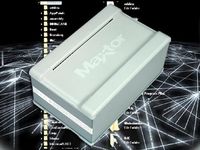Maxtor's Shared Storage Does NAS At Home
The Easy Way To Handle Data In A Home Network
What sounds simple and uncomplicated in theory can actually turn into something of a logistics problem in practice. What is to be done with all the data you collect over time? Hard drives with storage capacities of one terabyte are no longer exotic rarities and at a price of just over 10 cents per gigabyte, they are also more than affordable than ever. Even better, 1.5 TB drives are already shipping in quantity from Seagate.
The Problem: Many Computers And One Set Of Data
But even when you equip your computer with lots of storage capacity, this immediately brings you to the next problem. If there are several computers, and maybe even a home theater PC (HTPC) on the network, you want to be able to access all data at all times. This means that the computer on which the data is stored should also be switched on. For example, if you want to watch the film recording of last year’s summer holiday in the living room, or view the pictures of last year’s birthday celebration on the laptop. But with a power consumption of 100 watts or more, PCs put unnecessary stress on the environment, the power grid, and your wallet. There’s no need to have every computer in the house running 24/7. Network Attached Storage (NAS) devices are data storage units connected directly to the network, which makes them usually more economical in this respect.
Security Is Important
If you only save important data to a single disk in the computer, this can result in catastrophic loss sooner or later. Hard drives are not infallible, and a defect can result in the irretrievable loss of all of your data. Backup is absolutely essential when it comes to important information, and it is best to create a data backup on an external medium which can then be stored away from the computer in a safe place. This means that important files can still be retrieved even if the computer is damaged by theft or a natural disaster.
The use of DVDs as a backup medium for home use is ideal in view of the restoration options should the worst case scenario occur. But there’s something far more convenient about an automated process that doesn’t involve swapping in 4.7GB discs every few minutes, which is why we’re looking at using Maxtor’s Shared Storage II.
Get Tom's Hardware's best news and in-depth reviews, straight to your inbox.
Current page: The Easy Way To Handle Data In A Home Network
Next Page Data Storage With Redundancy For Home Use-
badboy4dee kwl review for this device. I wonder though if it allowed for mtu/jumbo, vpn security config n such. Prob not but that woulda been a nice touch.Reply
The Silent Majority -
deck These home NAS storage solutions need raid 5 and support for at least 4 drives. Until then my old AMD 500 will continue to chug away...Reply -
serp9000 "But the fact that a user may wish to replace the drives has not been taken into consideration. Should a drive fail and you need to replace it yourself, you’ll have to take the unit apart and break the warranty seal."Reply
If a drive fails and it's still under warranty, it would only seem logical to invoke the warranty protection and get a free drive. If a drive fails and it isn't under warranty, then breaking the warranty seal wouldn't be a problem. Doesn't seem like a particularly important detail. -
hellwig largerimagespleaseWhat's the point of the tiny images where I can't read anything?"...And so, with a clash of lightning that split apart the heavens, and with a mighty voice, God said unto Abraham: 'Click on the image twice you doofus!'".Reply
I do agree that clicking on the image once to get the main image page, and then a SECOND time to get the full-sized image is stupid, but if they were to insert the full-sized image in the main article, the article would be pretty hard to read through.
I had one of those little warranty stickers on my old Mactor One-Touch. With a razor and some patience you can get that sucker off without breaking it. -
snarfies1 serp9000If a drive fails and it's still under warranty, it would only seem logical to invoke the warranty protection and get a free drive.Reply
Except that this will involve sending your still perfectly functional drive away, where it will be perused by whoever while you have no access to it yourself. Not an acceptable solution to me. This is yet another FAIL solution for home NAS, I'm afraid. -
serp9000Reply
the problem is you'll have to do without your data while you wait for the warranty work. do you really trust sending out your one good copy? -
oldmangamer Let me see...Raid 1 means you can replace a failed drive with a new one and the second drive (the "mirror") still contains the data. But now, you have to replace the failed drive so the mirror can be rebuilt...but you cannot without voiding the warranty. Do I have this straight? If so, this is simply a disaster waiting to happen. Especially with the high drive failure rate reported by customers. Still waiting for a good home NAS.Reply -
xxsk8er101xx Buy this http://www.newegg.com/Product/Product.aspx?Item=N82E16817707125Buy your drives.Reply
Call it a day. -
kschoche Performance is lackluster at best, especially in raid-0! Let me rephrase, performance is TERRIBLE.Reply
The chances of the working disk getting damaged while shipping the whole box back for a single failed drive are WAY higher than the chances I'll damage it opening it, but considering the literacy of the users of such a slow NAS... I'll stick with my homebrew NAS kthx

